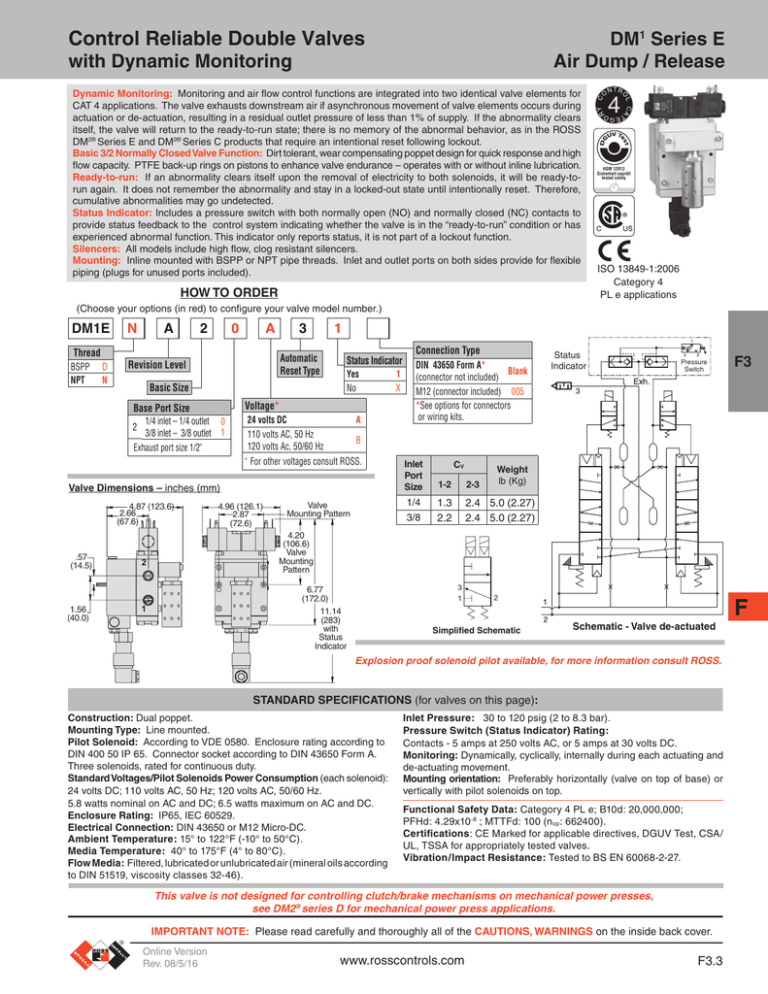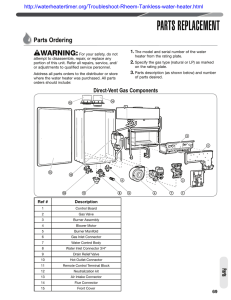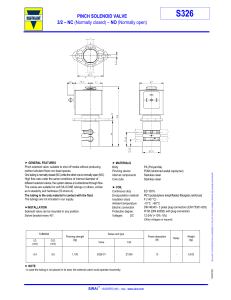
Control Reliable Double Valves
DM1 Series E
Air Dump / Release
with Dynamic Monitoring
Dynamic Monitoring: Monitoring and air flow control functions are integrated into two identical valve elements for
CAT 4 applications. The valve exhausts downstream air if asynchronous movement of valve elements occurs during
actuation or de-actuation, resulting in a residual outlet pressure of less than 1% of supply. If the abnormality clears
itself, the valve will return to the ready-to-run state; there is no memory of the abnormal behavior, as in the ROSS
DM2® Series E and DM2® Series C products that require an intentional reset following lockout.
Basic 3/2 Normally Closed Valve Function: Dirt tolerant, wear compensating poppet design for quick response and high
flow capacity. PTFE back-up rings on pistons to enhance valve endurance – operates with or without inline lubrication.
Ready-to-run: If an abnormality clears itself upon the removal of electricity to both solenoids, it will be ready-torun again. It does not remember the abnormality and stay in a locked-out state until intentionally reset. Therefore,
cumulative abnormalities may go undetected.
Status Indicator: Includes a pressure switch with both normally open (NO) and normally closed (NC) contacts to
provide status feedback to the control system indicating whether the valve is in the “ready-to-run” condition or has
experienced abnormal function. This indicator only reports status, it is not part of a lockout function.
Silencers: All models include high flow, clog resistant silencers.
Mounting: Inline mounted with BSPP or NPT pipe threads. Inlet and outlet ports on both sides provide for flexible
piping (plugs for unused ports included).
HOW TO ORDER
4
HSM 12013
Sicherheit seprüft
tested safety
√
ISO 13849-1:2006
Category 4
PL e applications
(Choose your options (in red) to configure your valve model number.)
DM1E N
Thread
BSPP
NPT
D
N
A
20 A3
1
Automatic
Reset Type
Revision Level
Status Indicator
Yes
No
Basic Size
Voltage*
Base Port Size
1/4 inlet – 1/4 outlet 0
2
3/8 inlet – 3/8 outlet 1
Exhaust port size 1/2"
24 volts DC
110 volts AC, 50 Hz
120 volts Ac, 50/60 Hz
A
Valve Dimensions – inches (mm)
.57
(14.5)
1.56
(40.0)
4.96 (126.1)
2.87
(72.6)
DIN 43650 Form A*
Blank
(connector not included)
M12 (connector included) 005
*See options for connectors
or wiring kits.
Status
Indicator
Pressure
Switch
F3
B
* For other voltages consult ROSS.
4.87 (123.6)
2.66
(67.6)
1
X
Connection Type
Valve
Mounting Pattern
Inlet
Port
Size
1-2
2-3
1/4
3/8
1.3
2.2
2.4 5.0 (2.27)
2.4 5.0 (2.27)
CV
Weight
lb (Kg)
4.20
(106.6)
Valve
Mounting
Pattern
2
3
1
6.77
(172.0)
11.14
(283)
with
Status
Indicator
1
2
Simplified Schematic
Schematic - Valve de-actuated
Explosion proof solenoid pilot available, for more information consult ROSS.
STANDARD SPECIFICATIONS (for valves on this page):
Construction: Dual poppet.
Mounting Type: Line mounted.
Pilot Solenoid: According to VDE 0580. Enclosure rating according to
DIN 400 50 IP 65. Connector socket according to DIN 43650 Form A.
Three solenoids, rated for continuous duty.
Standard Voltages/Pilot Solenoids Power Consumption (each solenoid):
24 volts DC; 110 volts AC, 50 Hz; 120 volts AC, 50/60 Hz.
5.8 watts nominal on AC and DC; 6.5 watts maximum on AC and DC.
Enclosure Rating: IP65, IEC 60529.
Electrical Connection: DIN 43650 or M12 Micro-DC.
Ambient Temperature: 15° to 122°F (-10° to 50°C).
Media Temperature: 40° to 175°F (4° to 80°C).
Flow Media: Filtered, lubricated or unlubricated air (mineral oils according
to DIN 51519, viscosity classes 32-46).
Inlet Pressure: 30 to 120 psig (2 to 8.3 bar).
Pressure Switch (Status Indicator) Rating:
Contacts - 5 amps at 250 volts AC, or 5 amps at 30 volts DC.
Monitoring: Dynamically, cyclically, internally during each actuating and
de-actuating movement.
Mounting orientation: Preferably horizontally (valve on top of base) or
vertically with pilot solenoids on top.
Functional Safety Data: Category 4 PL e; B10d: 20,000,000;
PFHd: 4.29x10 -8 ; MTTFd: 100 (nop : 662400).
Certifications: CE Marked for applicable directives, DGUV Test, CSA/
UL, TSSA for appropriately tested valves.
Vibration/Impact Resistance: Tested to BS EN 60068-2-27.
This valve is not designed for controlling clutch/brake mechanisms on mechanical power presses,
see DM2® series D for mechanical power press applications.
IMPORTANT NOTE: Please read carefully and thoroughly all of the CAUTIONS, WARNINGS on the inside back cover.
Online Version
Rev. 08/5/16
www.rosscontrols.com
F3.3
F
Control Reliable Double Valves
DM1 Series E
Valve Operation & Options
with Dynamic Monitoring
Valve de-actuated (ready-to-run): The flow of inlet
air pressure into the crossover passages from the inlet
chamber is restricted by orifices that allow air pressure to
bypass the lower inlet poppets. Flow is sufficient to quickly
pressurize the pilot supply/timing chambers on both sides
A and B. The upper inlet poppets prevent air flow from the
crossover passages into the outlet chamber. Air pressure
acting on the inlet poppets and return pistons securely hold
the valve elements in the de-actuated position. (Internal
air passages shown out of the valve body for clarity.)
B
Valve actuated: Energizing the pilot solenoids
simultaneously applies pressure to both pistons,
forcing the internal parts to move to their actuated
position, where inlet air flow to outlet is open and
both exhaust poppets are closed. The outlet is
then quickly pressurized, and pressure in the
inlet, crossovers, outlet, and timing chambers
are quickly equalized. De-energizing the main
solenoids causes the valve elements to return
to the ready-to-run (de-actuated) position.
A
EXHAUST
OUTLET
INLET
Asynchronous Operation: If the valve elements
operate in a sufficiently asynchronous manner
on ACTUATION, the valve will shift into a position where one crossover and its related timing chambers will be exhausted,
and the other crossover and its related timing chambers will be pressurized.
In the illustration, side B is in the de-actuated position, but has no pilot air available to actuate with and has full pressure on
its upper and lower inlet poppets and return piston to hold it in place.
Inlet air flow on side B into its crossover is restricted and flows through the open upper inlet poppet on side A, through the outlet
into the exhaust port, and from the exhaust port to atmosphere. Residual pressure in the outlet is less than 1% of inlet pressure.
Once the main solenoids are de-energized, actuating pressure is removed from the top of the main pistons and then the
lower inlet poppet return spring along with inlet air pressure acting on the side A return piston will push side A back into the
de-actuated position. Inlet air pressurizes the crossovers and volume chambers. Pressure in the crossovers helps hold the
upper inlet poppets on seat. The valve will then be in the ready-to-run position. On the next attempt to actuate normally, if
side B is still unable to actuate synchronously with side A, the same sequence of events described above will occur again.
F3
WARNING: If asynchronous operation occurs while DE-ACTUATING, the pilot
supply/timing chambers on one side will still be exhausted as described above.
However, this could be a temporary situation because the cause of the asynchronous
operation may be able to correct itself allowing the stuck or slow acting side of
the valve to eventually move back into the de-actuated position. Once the slow or
stuck side has de-actuated, the pilot supply/timing chambers that were exhausted
will then repressurize. If an external monitoring system is only checking the status
indicator periodically this fault signal could be missed. The machine’s safety system
must be designed to ensure that this does not cause a hazardous situation.
A
B
.004.004
.004
EXHAUST
OUTLET
INLET
B
A
EXHAUST
OUTLET
INLET
Valve in restricted
outlet to exhaust state
Status Indicator: The status indicator
pressure switch will actuate when the
main valve is operating normally, and
will de-actuate when the main valve
operation is sufficiently asynchronous
or inlet pressure is removed. This
device is not part of the valve lockout
function, but, rather, only reports the
status of the main valve.
Status indicator
in normal
ready-to-run position
Options
Electrical
Connector
Form
Electrical
Connectors
Cord Length
Cord
meters (feet) Diameter
Electrical Connector Type
DIN 43650 Form A Prewired Connector (18 gauge)
DIN 43650 Form A Prewired Connector (18 gauge)
Connector for threaded conduit
DIN 43650 Form A
(1/2 inch electrical conduit fittings)
DIN 43650 Form A Connector Only
F
Electrical Connector Model Number
Lighted Connector
Without
Light
24 Volts DC
120 Volts AC
2 (61/2)
2 (61/2)
6-mm
10-mm
721K77
371K77
720K77-W
383K77-W
720K77-Z
383K77-Z
–
–
723K77
724K77-W
724K77-Z
–
–
937K87
936K87-W
936K87-Z
CAUTIONS: Do not use electrical connectors with surge suppressors, as this may increase valve response time when de-actuating the solenoids.
Downstream Pressure Monitoring
Model
Number
Normally Open
Common
Normally
Closed
3
Pressure Switches
Connection Type
DIN Connector Pinout
2
Port
Threads
1
Ground
M12 Connector Pinout
DIN 43650 Form A 586A86
1/8 NPT
M12 Micro-DC
1153A30 1/8 NPT
*Pressure switch closes on falling pressure of 5
psig (0.34 bar).
Pin 4
Pin 3
Normally Open Not Used
Pin 1
Common
Pin 2
Normally
Closed
Model Number Port Threads
Redundant
Downstream
RC26-13
3/8 NPT
Feedback Switch
• May be installed downstream on all double valves
• Provides a redundant means to verify the release of
downstream pressure to next obstruction
• Factory preset, 5 psi (0.3 bar) - falling
A
High-Flow, High Reduction Silencer Kits
Kit Number*
Basic
Size NPT Threads
BSPP Threads
2
2323H77
2328H77
Avg. CV
A
Dimensions inches (mm)
B
B
(NPT)
(BSPP)
C
B
256 (121) 4.96 (126.1) 14.24 (361.7) 16.05 (407.7) 5.68 (144.3)
* Kits include all plumbing required for installation. Pressure Range: 125 psig (8.6 bar) maximum.
Designed to improve equipment performance and reduce the Exponentially Perceived Noise (EPNdB) in the
35–40 dB range.
C
IMPORTANT NOTE: Please read carefully and thoroughly all of the CAUTIONS, WARNINGS on the inside back cover.
F3.4
© 2016, ROSS CONTROLS®. All Rights Reserved.
Online Version
Rev. 08/05/16
Control Reliable Double Valves
DM1 Series E & C
Preassembled Wiring Kits
with Dynamic Monitoring
Kit Number
Solenoid Connector Type
Length meters (feet)
2243H77
2244H77
2245H77
2246H77
DIN 43650 Form A
DIN 43650 Form A
M12 Micro-DC
M12 Micro-DC
5 (16.4)
10 (32.8)
5 (16.4)
10 (32.8)
Solenoid Cables
with DIN Connector
Status Indicator Cable
with DIN Connector
These kits include 2 cables with either DIN or M12 connectors
for the solenoids. All cables include cord grips.
GRN/YEL
GROUND
GRY
4
NOT USED
BRN
PIN 1
BRN
1
2
3
GRN/YEL
GROUND
BRN
3 BLK
1
BRN
GRY
PIN 2
BLK
GRN/YEL
2
GRY
Status Indicator Cable
with DIN Connector
Status Indicator kit ordered separately.
Status
Indicator Kits
Solenoid Cables
Solenoid Cables
with M12 Connector with DIN Connector
Kit Number Length meters (feet)
2247H77
2248H77
5 (16.4)
10 (32.8)
3
BLUE
1
4
4
BLACK
Status Indicator kits include one cable with DIN
connector and a cord grip.
F3
2
3
3
BLUE
BRN
PIN 1
4
GRY
PIN 2
BRN
BRN
1
2
3
GRN/YEL
GROUND
BLK
3 BLK
BLUE
1
BRN
GRN/YEL
2
GRY
Wiring Kits with J-Box
Kit Number*
Connector Types
Length meters (feet)
2249H77
M12 - DIN
2250H77
M12 - M12
1 (3.3)
1 (3.3)
A J-Box is a junction box with a 10-pin MINI connector for connecting to the user’s control
system and (4) 5-pin M12 ports for connecting to the 3 solenoids and the status indicator on
the DM2® Series valve. The J-Box kits include the J-Box as described above and (4) 1-meter
cables for connecting to the valve. These cables have a connector on each end. The status
indicator cable and the (3) solenoid cables have an M12 connector on one end and a DIN
connector on the other end (M12-DIN).
1.85 (46.9)
2.90 (73.6)
Standard valves come with DIN type
solenoid connections, but could be
2.0
8 1
7
bought with M12 type connections as
(51)
1.41
6 9 10 2
(35.9)
5
3
well. Therefore we also offer a kit that
dia.
4
0.18
provides solenoid cables with an M12
[4.5]
connector on each end (M12-M12).
1.125 - 16UN2A
3.9 (100)
10 PIN MINI Cable
Kit Number
Length meters (feet)
2253H77
2254H77
2255H77
2256H77
3.66 (12)
6.1 (20)
9.1 (30)
15.2 (50)
Port 1
Pin #
10 Pin
Pin #
*24 volts DC only.
F
GRN/YEL
GROUND
GRY
NOT
USED
4
BLACK
BLUE
1
3
(V+) 1
(V-) 2
3
4
5
6
7
8
9
10
7
6
Port 3
Pin #
Port 4
Pin #
1
3
1
3
1
3
2
4
4
2
4
2
2
4
8
1
9 10
5
Port 2
Pin #
4
2
3 5 4
1
2
3 5 4
2
1
3 5 4
1
2
3 5 4
1
2
3
J-Box Wiring
These cables have a 10-pin MINI connector for connecting the J-Box kits above to the user’s control system.
Kits include one cable with connector and cord grip. Cable conductors are 18-gauge wire.
PIN #
1 +24 volts DC
2 Common volts DC
3 4 Solenoid A
5 Solenoid B
PIN #
6 7 Remote Reset
8 9 Remote Valve Fault Light
10 Remote System OK Light
Wire Colors:
Orange
Blue
White w/Black
Red w/Black
Green w/Black
Wire Colors:
Orange w/Black
Red
Green/Yellow
Black
White
8
7
6
9
5
1
10
2
3
4
Outlet Port Pressure Monitoring Wiring Kit
Kit Number
Length meters (feet)
2251H77
1 (3.3)
Ø0.6
(10)
0.4
(40) 1.6
Some customers prefer to monitor downstream
(40)
(17)
1.6
pressure in addition to using the DM2® or DM1 Series
M12x1 0.7
valve. A convenient way to do this is to install a pressure
Female
M12x1
switch in the extra outlet port that is provided on the
Male
valve. The Outlet Port Pressure Monitoring kit can be
used with one of the J-Box kits above to split one of the M12 ports on the J-Box so that a pressure switch
can be wired in as well. These kits consist of one port splitter (a Tee with three M12 connectors) and one
M12-DIN cable (1 meter).
FEMALE
A 1
PORT SPLITTER
2
3
4
5
5
MALE
4
3
3
2
5
2
4
1
Pressure switch available separately, see valve options.
IMPORTANT NOTE: Please read carefully and thoroughly all of the CAUTIONS, WARNINGS on the inside back cover.
F3.8
© 2016, ROSS CONTROLS®. All Rights Reserved.
Online Version
Rev. 08/05/16
1
FEMALE
B
1
2
3
4
5


